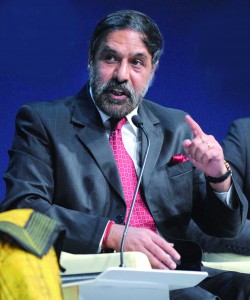
Mr. Anand Sharma, Minister for Commerce, Industry & Textiles, has welcomed the announcements made by the Finance Minister on the textiles sector in his Budget speech.
Delivering the keynote address at the one-day conference on National Consultation on the Handloom Sector, Mr. Sharma said that the announcement for providing fresh working capital and term loans to weavers at a substantially low rate of only six per cent against the earlier high rate of 14 per cent without interest subvention or 11 per cent with three per cent interest subvention will benefit 1.5 lakh individual weavers and 1,800 primary co-operatives. “This is perhaps for the first time that such a big policy roll out in sync with the demands of this community has been announced by any Government, and I am confident that this single policy initiative of the UPA Government will become a game changer for this sector. Our aim was to bring this at par with Khadi, and we have done this”.
He said the Textiles Ministry is in the process of making a paradigm shift in how it defines the handloom sector, without compromising on its core strength of being a hand-woven sector. “After intense stakeholder consultations, we, under the Handloom Reservation of Articles for Production Act, 1985, propose to include hybrid looms where one of the three primary motions of shedding, picking and beating can be mechanical.”
Mr. Sharma expressed the hope that this will greatly help weavers as this will not only be in sync with ground realities but also substantially reduce the drudgery associated with weaving. Further, this would be done without a conflict of interest with the hand-woven technique, which is the exclusive domain of this sector and also its core strength.
Mr. Sharma proposed a new Comprehensive Integrated Handloom Cluster Scheme for 5,000 plus handlooms to complete the missing link in terms of providing infrastructure support to the handloom sector. He also proposed that the facility of making available at subsidised rates cotton and silk yarn under the 10 per cent price subsidy scheme for which a provision of Rs. 1,300 crores has been made in the financial package through the agency of the National Handloom Development Corporation (NHDC), be extended to other fibres like jute, wool and coir. “This will greatly benefit the large but scattered concentration of looms and weavers in the north-east region as there is also a 2.5 per cent transport subsidy available under this package.”
Mr. Sharma further observed that in order to extend the outreach of the Handloom Package to cover more co-operative societies, “the Ministry has proposed certain amendments as demanded by a large number of States, whose Chief Ministers have written to me to relax the net worth and norms for potentially viable societies.”
Commenting on the question of issuance of weavers credit cards, he said his Ministry, at a meeting with the CMDs of major nationalised banks, has conveyed to them that no stone should be left unturned in making credit available to weavers through a single window mechanism without undue hassle of filling up too many forms or making repeated visits to the banks. He promised weavers to review it on a fortnightly basis.
Mr. Sharma also referred to the steps taken by the Government in making exports from this sector competitive in the international market. “To promote exports, several fiscal incentives and interventions have been provided under the Foreign Trade Policy. Kannoor in Kerala, Karur and Madurai in Tamil Nadu and Khekra in UP have been designated as Towns of Export Excellence. Moreover, two per cent interest subvention under the Focus Product Scheme has been extended to the handloom sector till March, 2014, to arrest decline in its exports which fell by 11 per cent last year. The Budget has also exempted hand-woven carpets from excise duty,” he added.